► Ferrari SF90 XX vs Lambo Revuelto
► Hybrid hypercars battle it out
► A long-standing rivalry reignited
Two households, alike in dignity,
In fair Emilia-Romagna where we lay our scene,
From ancient grudge break to new mutiny,
Where civil blood makes civil hands unclean.
Scuderia red leads gunmetal grey down the hillside in new mutiny, the scarred, bone-coloured tarmac drying fast after this morning’s dark-sky deluge. Sunlight cuts through steam as the road bakes from greasy to grippy, the grasses at the verge swaying against shimmering armco. In the Revuelto’s cockpit, high as a kite and climbing, I find just enough time between corners to take a mental snapshot. I also make the time to smile, because if this isn’t fun then I don’t know what is. But now – speeding Lamborghini beneath me, flying Ferrari ahead – it’s all gone horribly wrong.
In that phase between thinking you know a road and actually knowing it, I have gone in too hot. I ease off the brakes, pour the Lamborghini’s arrowhead prow into the third-gear sweeper… and watch in horror as the apex skips ahead out of sight around what is actually a second-gear hairpin. The Revuelto’s V12 sits open to the sky behind the cockpit like a holy relic, uncovered for visiting pilgrims, and right now I could use a miracle.
It’s too late to do anything but secure any loose luggage, hold my breath (always helps) and add steering lock. The terminal understeer does not come. Instead this brutally cab-forward weapon of a car simply tightens its trajectory, protests in no obvious way and rails around the corner like that was our plan all along.
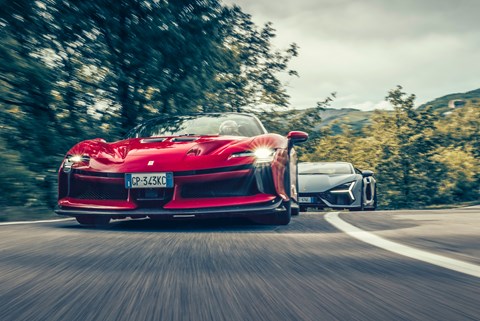
This is a relatively recent development, of course. Italian hypercars with F1 power outputs didn’t used to be able to forgive, just as they didn’t used to be able to handle anything rougher than an FIA-approved pista. If the SF90 XX and the Revuelto achieve nothing else they should banish forever the notion that Italian supercars are smooth-surface junkies without a shred of pliancy or mercy. Nothing could be further from the truth. These roads, utopian just a few short years ago, are fast becoming a disgrace; distorted by subsidence, ravaged by wet winters and traffic-battered. But neither car cares, their lovingly calibrated, impossibly expensive suspension working miracles to keep wheels on road and your breakfast where you put it.
As the next straight opens out I briefly consider not clacking the throttle pedal to the stop, in deference to our recent brush with oblivion. But no; 90-year-old me, covered in biscuit crumbs watching daytime TV, won’t fondly recall the time he short-shifted a 6.5-litre V12 as a scarlet SF90 XX danced into the distance.
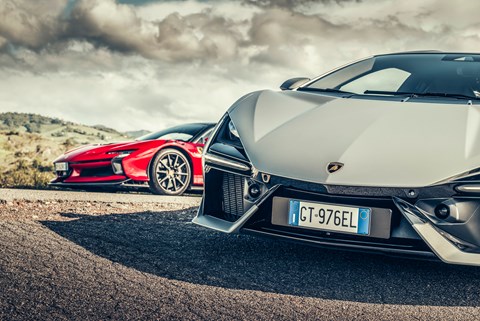
So I give it everything, free-falling again into the impossible reach of that electrically-boosted masterpiece, the V12 comfortingly familiar even if the kinetic violence it helps unleash is new and alien in its lag-free ferocity. Once upon a time you had to wind up engines like this, their revs and your speed unwinding across the landscape like the shadows of fast-moving clouds. In the Revuelto there is no waiting – and the V8 Ferrari exhibits less latency still. Acceleration is instantaneous, irresistible and endless. Sure, one must obey the speed limit. But we can play fast and loose with a few laws of physics.
That’s why we’re here – for the latest, violent chapter in the story of the greatest rivalry on the planet. And what better practical means of exploring the relationship between the acceleration of an object and the forces acting upon it – not to mention the effect of those forces upon your heart and soul – is there than the meeting, finally, of Italy’s most advanced plug-in-hybrid powerhouses?
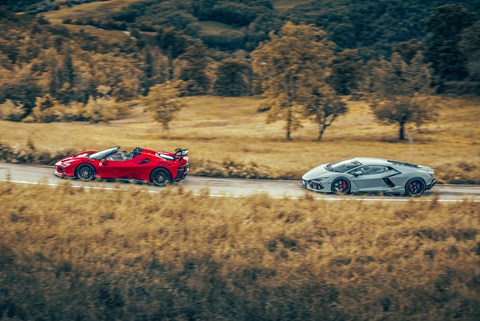
Although the SF90 XX and the Revuelto were born on different drawing boards the engineering concepts are remarkably similar. One’s a V12, of course, rated at 825bhp, while the SF90 XX employs a 4.0-litre twin-turbo V8 good for 786bhp. But in both cases three e-motors (one on each front wheel and a third driving the rear wheels) further inflate the bottom line (the Ferrari’s front motors are, at 229bhp, more powerful than the Lambo’s 148bhp units, and draw power from a bigger battery). These bolster the Ferrari’s system total to 1016bhp and the Lamborghini’s to 1001bhp.
While the raging bull is currently only available as a fixed-head coupe, the prancing horse was also briefly offered as a Spider with a powered folding hardtop. The fleet of 1398 XXs was declared sold within hours of its announcement, in early summer 2023 – no mean feat considering the Spider’s list price of £747,197. At £447,000 the Revuelto looks almost affordable. The waiting list stretches way into 2026, when we expect the roadster to join it as a 2027 model.
Though the two contenders are separated by the average UK house price, money isn’t the point. Daytona and Miura, Testarossa and Countach, 458 and Huracan, Purosangue and Urus Performante – this war’s been raging since the ’60s and peace talks feel a long, long way off. Even if you’re able to put the history to one side, dilemmas such as this are not matters of the head. The battle of the horse and the bull is waged in the hairs on the back of your neck, the pit of your stomach and in the unknowable desires of the fickle human heart.
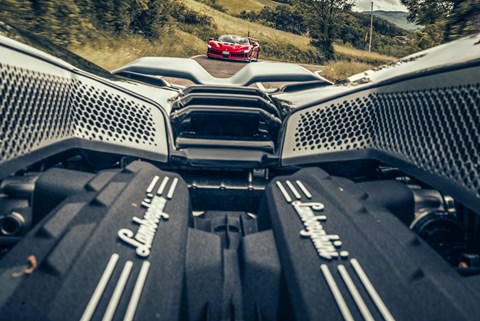
If your eyes call the shots you’ll likely buy the Lamborghini. Its rakish proportions – like its V12 engine, rich with echoes of the past – have centrefold quality, the design totally true to the brand. But today, in red and with more aero than a mid-season F1 upgrade, it’s the Ferrari that keeps snaring passing eyeballs. Both look like they’re doing 190mph even at rest – and of course both can do 190mph in short order. The Lamborghini’s good for 0-62mph in 2.5sec and 0-124mph in an official ‘less than seven seconds’; the Ferrari, in Qualifying mode with Extra Boost, 0-62mph in a savage 2.3 seconds and 0-124mph in just 6.7 seconds.
This is Ferrari’s first street-legal XX model, and the go-faster package is a brutally expensive yet fairly thin icing on the SF90 cake. Net gains are a token weight saving of 10kg, quantifiably more high-speed aerodynamic grip, a beautifully crafted and highly, erm, expressive bodykit, a de-contented cockpit and another 30bhp (17bhp from the V8; 13bhp from the axial-flow rear e-motor). Talk about the air getting thin at the top… Top speed is down versus the ‘base’ Spider’s 211mph to ‘just’ 199mph, thanks mainly to that vast fixed rear wing, the first of its type on a roadgoing Ferrari since the F50.
While the SF90’s interior looks vaguely like the deluxe version of Leclerc’s F1 racer, the Revuelto cabin is more cohesive and stylish, though gaudy graphics threaten to undo all that good work. You’d happily spend hours in here, should you and your V12 be required several hundred miles away, but it lacks the Ferrari’s drama.
Four tiny knobs are attached to the wheel. The lower ones operate the front axle lift and the rear spoiler. The ones on top select the drive program (electric, Sport, Corsa and ESC off) and the EV status (Charge, Hybrid and Performance). In total, you have 13 different modes to choose from. The XX pairs touch controls for the powertrain (eDrive, Hybrid, Performance and Qualifying) with a physical manettino for the drive mode selection (Wet, Sport, Race, CT off and ESC off). And there’s a lot more happening besides on this steering wheel, including touch controls for the lights, wipers, voice prompt, infotainment and engine start/stop. You yearn for a physical start button, but don’t worry – the powertrain disappointment ends there.
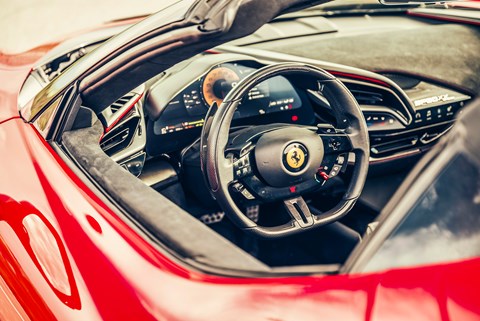
Space-wise there’s not much in it; the SF90 XX feels more cramped, and its metal floor is slippery when wet, but the Revuelto’s prominent A-pillars get in the way on tighter roads. Climb into the Ferrari, drop into its bucket seat and you soon get a sense of the car’s priorities. Unadjustable in any way other than backwards or forwards, the seats are at least set wonderfully low. They also set the tone, working beautifully when it comes to the communication of feedback, even if their vice-like grip has no time nor patience for surplus meat on your hips. Despite its part-time roof, the XX feels like a racecar.
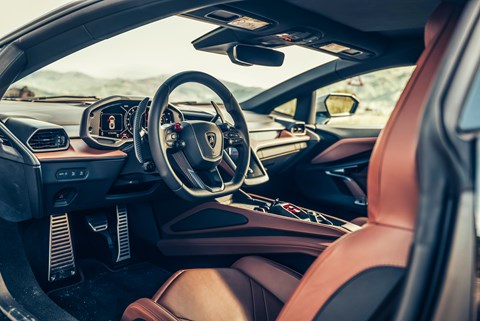
Perhaps stung by criticism of the non-XX SF90’s paucity of character, Maranello’s dialled the XX’s powertrain way up. Get greedy on the long-travel throttle pedal and the Ferrari merrily assaults time, distance and most of your five senses. Up to 5000rpm it sounds like a pair of highly tuned hot-cam fours. From there to the redline il concerto molto furioso is enriched by a yell reminiscent of a MotoGP bike at full cry, cross-pollinated with the sci-fi racket of Ferrari’s Le Mans-winning 499P. Really want to feel the noise? Keep the roof up but drop the small rear window, which passes all of the above through a stack of Marshall amps the size of the Great Wall of China.
The V12 has its own identity, of course: more multi-faceted, strident and without doubt more musical. And while there’s nothing in it for point-to-point speed the XX feels faster, simply because it insulates you less. Assuming you’re in the right drive mode and shifting manually (the car’s essentially comatose if driven in the modes to which it defaults on start-up), each straight is less a sequence of rising revs and drawn-out gearchanges and more a barrage of shifts, each apparently exacerbating the car’s appetites for speed and ratios rather than sating them. The XX’s unholy electro-mechanical union doesn’t so much work through gears as crisply delete them.
The Ferrari’s brakes, thankfully, are sensational. Together with the plugged-in driving position and fast, accurate steering, they help make an addictive plaything of this monstrous machine. Are we getting carried away? Probably. This morning, on greasy tarmac, Race mode permitted as much rear-end lewdness as we could stomach. But now that the road is dry and our rubber warm (our XX is on wet-weather-ready Bridgestone runflats – on Cup Michelins it must induce nosebleeds), CT-off sets the car free. (In the more cautious modes you feel it working harder than Dolly Parton to dull the delivery, manage the torque and keep your corner exits clean.)
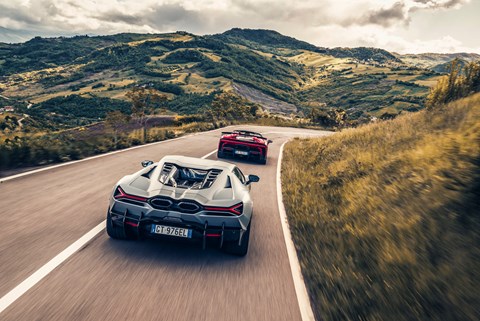
Mid-corner lateral grip is the stuff of dreams, the Ferrari pushing into shades of understeer or oversteer as directed by your inputs with wheel, brakes and throttle. As the road gets really wild you expect the racier Ferrari to stretch a gap but the Lamborghini’s no slower here despite its broader remit; the Revuelto, so sweetly balanced and more rounded near the limit, doesn’t ask that you nanny a rear end that feels keen to get away. The Ferrari’s a touch snappier and harsher in its actions, the Lamborghini’s composure often countering any corner-speed advantage the XX might bring to bear.
Going hard now, the two cars back-to-back, and the Ferrari opens up like a flower, revealing more of itself as the driving edges towards the kind of work for which it was intended. At the same time the difference between the two cars grows more and more pronounced, the XX pilot living millisecond to millisecond, on wits and reflexes, while the Revuelto – tuned for less drama and more confidence – is unfazed as you ask more and more of it; more decisive inputs at the wheel, more rotation on turn-in and more throttle earlier and earlier, both cars’ surreally strong traction letting you wring out these two remarkable powertrains as you might a holiday-rental Panda. Equipped with its fixed-ratio rack and rear-wheel steering (the latter is absent on the Ferrari), the Revuelto is 1001bhp putty in your palms.
Spoiler-less, the Lamborghini feels no less tied down than its rival at these speeds, and with its accessibility the Revuelto comfortably eclipses the knobbly, hectic Aventador. The biggest individual improvement over that car and its crude and slow ISG ’box is the Revuelto’s eight-speed twin-clutch transmission, mounted aft of the V12. Versus the old car the wheelbase has been stretched to generate 80mm more legroom and, since front-wheel drive is now fully electric, with no propshaft required, the engine is carried lower.
Weight distribution is 44:56 front to rear and, at 1772kg, the dry weight is heftier than the Ferrari’s by 112kg – to be expected, given the increased creature comforts and big V12. That said, the Ferrari’s battery is twice the size – 7.9kWh to the Revuelto’s 3.8 – for a claimed pure-electric range of 16 miles to the Lamborghini’s eight-ish. And if electric-only driving feels like anathema to cars like these, well, don’t be so sure. First thing this morning, crawling out of Maranello and then running south at speed to the hills as the rain fell, eHybrid – the V8 silent behind us – was a joy; quiet, refined, calm.
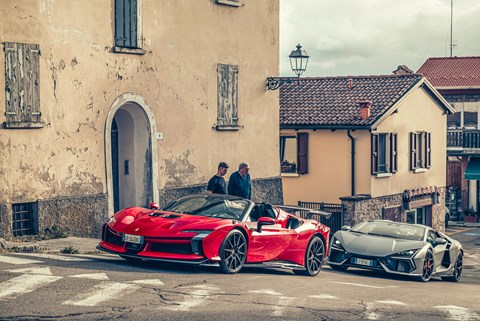
Both cars ride better than their uncompromising DNA would suggest is plausible, but the Revuelto is undoubtedly the more hospitable option, with more space, less extreme seats, easier access and some stowage space, both behind the seats and in the nose. It is a 24/7 supercar, whatever that means; less demanding and more usable, its deftly calibrated torque vectoring giving it a composure and an exploitability entirely at odds with its towering performance figures.
The SF90 XX is a troubled soul, born of a contradictory brief into a world that doesn’t recall asking for it. Flawed in many ways, it nonetheless hits like few cars ever created. Hard work and fiendishly addictive, it leaves you wrung out yet twitching for the next drive. In that regard at least, the most advanced Ferrari hypercar ever conceived shares something with the analogue legends on whose shoulders these two stand.